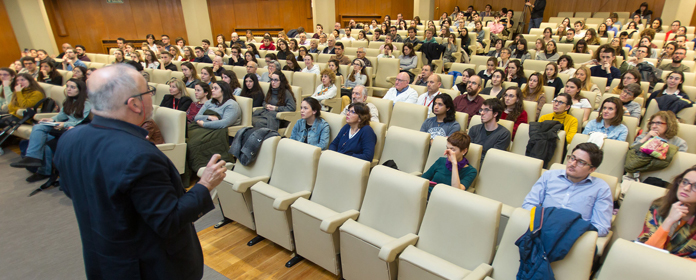"Whether disease occurs depends not only on the virus, but also on the host and the environment."
The Full Professor of Microbiology, Ignacio López-Goñi, gave a lecture lecture within the cycle 'The Science Museum explains'.

PHOTO: Manuel Castells
What is a virus? Where does the coronavirus come from and how does it spread? Is the epidemic coming to an end? The microbiologist and director of the Science Museum of the University of Navarra, Ignacio López-Goñi, answered these and other questions during the lecture that he gave at auditorium of Hexagon Building, within the cycle 'The Museum Explains'.
Taking as reference letter the words of director of WHO, Tedros Adhanom, López-Goñi assured that science and institutional cooperation are the tools to face this subject of epidemics. reference letter Specifically, the professor spoke about the concept of 'One Health', which refers to the common care of human, veterinary and environmental health. He added that, beyond the health alert, an epidemic such as that of the coronavirus generates serious economic, social and political consequences.
The professor offered some basic notions about the behavior of viruses. "The occurrence of a disease does not depend only on the virus, but also on the host and the environment". Factors such as population density, climate, humidity, etc., are core topic for its emergence. Whether an epidemic or a pandemic occurs depends on how these factors interact. "Coronavirus is not a pandemic," he clarified. The reason is that the virus has not been equally lethal in all the countries through which it has spread.
López-Goñi explained that virus mutations can occur in two different ways. First, as a small, one-off change in their sequence (this is the case, for example, with seasonal influenza). "What all scientists expect is the arrival of the 'Big One', a mixture or recombination of strains for which there is no prior immunity. That would indeed entail dramatic consequences, similar to those of the so-called 'Spanish Flu' of 1918," he said.
The professor clarified that the term 'coronavirus' does not refer reference letter only to the strain that emerged in China (whose exact nomenclature is COVID-19), but describes the form of the virus itself. In fact, as the academic said, "30 to 40% of common colds are caused by coronaviruses". López-Goñi cited some examples of previous strains similar to the current coronavirus, such as SARS Co-V or MERS (Middle East Respiratory Syndrome coronavirus).
López-Goñi concluded that in the case of the COVID-19 coronavirus we are dealing with a strain of intermediate transmissibility and lethality (its case fatality rate is close to 3% internationally). "It is less deadly than Ebola, but more deadly than seasonal influenza. In his opinion, "we could be coming to the end of this epidemic, since the issue of people affected is decreasing".




